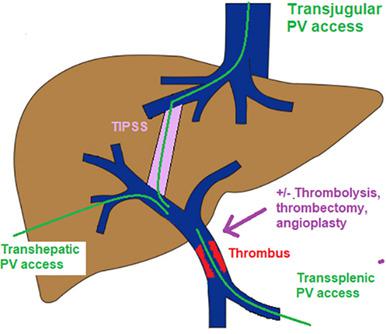当前位置:
X-MOL 学术
›
J. Dig. Dis.
›
论文详情
Our official English website, www.x-mol.net, welcomes your feedback! (Note: you will need to create a separate account there.)
Transjugular intrahepatic portosystemic shunts in portal vein thrombosis: A review
Journal of Digestive Diseases ( IF 3.5 ) Pub Date : 2021-07-29 , DOI: 10.1111/1751-2980.13035 Sern Wei Yeoh 1, 2 , Hong Kuan Kok 3, 4
Journal of Digestive Diseases ( IF 3.5 ) Pub Date : 2021-07-29 , DOI: 10.1111/1751-2980.13035 Sern Wei Yeoh 1, 2 , Hong Kuan Kok 3, 4
Affiliation

|
The presence of portal vein thrombosis (PVT) has previously been considered a contraindication to the insertion of transjugular intrahepatic portosystemic shunts (TIPSS). However, patients with PVT may have portal hypertension complications and may thus benefit from TIPSS to reduce portal venous pressure. There is an increasing body of literature that discusses the techniques and outcomes of TIPSS in PVT. This review summarizes the techniques, indications and outcomes of TIPSS in PVT in published case reports, case series and comparative trials, especially regarding the reduction in portal hypertensive complications such as variceal bleeding. A comprehensive literature search was conducted using MEDLINE and PubMed databases. Manuscripts published in English between 1 January 1990 and 1 March 2021 were used. Abstracts were screened and data from potentially relevant articles analyzed. TIPSS in PVT has been reported with high levels of technical success, short-term portal vein recanalization and long-term PV patency and TIPSS patency outcomes. Several comparative studies, including randomized controlled trials, have shown favorable outcomes of TIPSS compared with non-TIPSS treatment of PVT complications. Outcomes of TIPSS with PVT appear similar to those in TIPSS without PVT. However, TIPSS may be more technically difficult in the presence of PVT, and such procedures should be performed in expert high-volume centers to mitigate the risk of procedural complications. The presence of PVT should no longer be considered a contraindication to TIPSS. TIPSS for PVT has been acknowledged as a therapeutic strategy in recent international guidelines, although further studies are needed before recommendations can be strengthened.
中文翻译:

门静脉血栓形成的经颈静脉肝内门体分流术:综述
门静脉血栓形成 (PVT) 的存在以前被认为是插入经颈静脉肝内门体分流术 (TIPSS) 的禁忌症。然而,PVT 患者可能有门脉高压并发症,因此可能受益于 TIPSS 以降低门静脉压力。越来越多的文献讨论了 PVT 中 TIPSS 的技术和结果。本综述总结了已发表的病例报告、病例系列和比较试验中 PVT 中 TIPSS 的技术、适应症和结果,特别是关于减少静脉曲张静脉出血等门脉高压并发症。使用 MEDLINE 和 PubMed 数据库进行了全面的文献检索。使用了 1990 年 1 月 1 日至 2021 年 3 月 1 日期间以英文出版的手稿。筛选摘要并分析来自潜在相关文章的数据。据报道,PVT 中的 TIPSS 具有高水平的技术成功、短期门静脉再通和长期 PV 通畅和 TIPSS 通畅结果。包括随机对照试验在内的几项比较研究表明,与非 TIPSS 治疗 PVT 并发症相比,TIPSS 的疗效更好。带 PVT 的 TIPSS 的结果与不带 PVT 的 TIPSS 的结果相似。然而,在存在 PVT 的情况下,TIPSS 在技术上可能更困难,此类程序应在专业的大容量中心进行,以降低手术并发症的风险。PVT 的存在不应再被视为 TIPSS 的禁忌症。在最近的国际指南中,PVT 的 TIPSS 已被确认为一种治疗策略,
更新日期:2021-09-17
中文翻译:

门静脉血栓形成的经颈静脉肝内门体分流术:综述
门静脉血栓形成 (PVT) 的存在以前被认为是插入经颈静脉肝内门体分流术 (TIPSS) 的禁忌症。然而,PVT 患者可能有门脉高压并发症,因此可能受益于 TIPSS 以降低门静脉压力。越来越多的文献讨论了 PVT 中 TIPSS 的技术和结果。本综述总结了已发表的病例报告、病例系列和比较试验中 PVT 中 TIPSS 的技术、适应症和结果,特别是关于减少静脉曲张静脉出血等门脉高压并发症。使用 MEDLINE 和 PubMed 数据库进行了全面的文献检索。使用了 1990 年 1 月 1 日至 2021 年 3 月 1 日期间以英文出版的手稿。筛选摘要并分析来自潜在相关文章的数据。据报道,PVT 中的 TIPSS 具有高水平的技术成功、短期门静脉再通和长期 PV 通畅和 TIPSS 通畅结果。包括随机对照试验在内的几项比较研究表明,与非 TIPSS 治疗 PVT 并发症相比,TIPSS 的疗效更好。带 PVT 的 TIPSS 的结果与不带 PVT 的 TIPSS 的结果相似。然而,在存在 PVT 的情况下,TIPSS 在技术上可能更困难,此类程序应在专业的大容量中心进行,以降低手术并发症的风险。PVT 的存在不应再被视为 TIPSS 的禁忌症。在最近的国际指南中,PVT 的 TIPSS 已被确认为一种治疗策略,



























 京公网安备 11010802027423号
京公网安备 11010802027423号